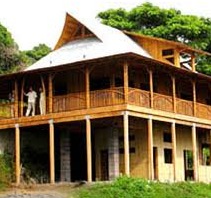Bamboo Construction and Inspection
by Nick Gromicko, CMI®
Bamboo is a type of hollow grass native to many areas of the world, most notably the Far East and Southeast Asia. It is sometimes thought of as the "poor man's building material" because of its widespread cultivation and use in tropical climates where much of the world's poor live. Many of these cultures find use for bamboo as food,  medicine, and as a material for fashioning everyday objects, such as cutlery and bicycles, in addition to being used as a building material. More recently, bamboo has been gaining traction in the West as a practical, aesthetically pleasing and environmentally friendly building alternative.
medicine, and as a material for fashioning everyday objects, such as cutlery and bicycles, in addition to being used as a building material. More recently, bamboo has been gaining traction in the West as a practical, aesthetically pleasing and environmentally friendly building alternative.
Facts and Figures
- There are over a thousand distinct species of bamboo; however, only around 10% to 15% of these have been classified as suitable for use in construction.
- In Hong Kong, bamboo is commonly used as scaffolding for skyscrapers.
- Bamboo is sacred to many cultures. In India, it signifies friendship, and in China, it signifies longevity.
Advantages of Bamboo
- Bamboo is an extremely strong natural fiber, on par with standard hardwoods, when cultivated, harvested, prepared and stored properly. The strongest part of a bamboo stalk is its node, where branching occurs.
- Bamboo is an exceptionally versatile material. It is used in a myriad of ways for building, such as for scaffolding, roofing, flooring, concrete reinforcement, walls and piping. It may be used structurally and as a decorative element.
- Bamboo is extremely flexible. During its growth, it may be trained to grow in unconventional shapes. After harvest, it may be bent and utilized in archways and other curved areas. It has a great capacity for shock absorption, which makes it particularly useful in earthquake-prone areas.

- Bamboo is extremely lightweight as compared with hardwoods. Consequently, building with bamboo can be accomplished faster than building with other materials. Cranes and other heavy machinery are rarely required.
- Bamboo is considered to be a sustainable and renewable alternative to hardwoods, foremost because it regenerates at exceptionally fast rates. Some bamboo species have been known to grow more than several feet per day. A bamboo forest may be harvested every six years, while hardwood forests may require decades between harvests.
- Bamboo is cost-effective, especially in areas where it is cultivated and is readily available. Transporting lightweight bamboo is less costly than transporting its heavier alternatives.
- Construction using bamboo ordinarily does not require machinery and can be accomplished with simple tools.
- Bamboo is as long-lasting as its wooden correlates, when properly harvested and maintained.
Disadvantages of Bamboo
- Bamboo does not contain cross fibers and is, consequently, not designed to bear weight width-wise, with the exception of the points at the nodes. Bamboo is prone to splitting, especially when standard construction fasteners, such as bolts, screws and nails, are inserted. Special fastening techniques are required when joining pieces of bamboo.

- Bamboo does not lend itself to being painted because of its natural waxy coating. Excessive dying or bleaching of bamboo may diminish its structural integrity.
- Bamboo is prone to insect invasion, especially when not treated properly after harvest. Hazardous pesticides are used on some bamboo, including DDT.
- Untreated bamboo is prone to breaking down if it comes in contact with excess moisture.
- Bamboo that has been harvested prematurely cannot bear as much weight as its more mature counterparts.
- Natural variations in species and handling mean that it may be difficult for installers to accurately gauge the quality of bamboo material.
- Designing and constructing with bamboo requires a special skill set that the average contractor may not possess.
Inspection
- Concrete should be regularly inspected for cracking when untreated bamboo has been used as reinforcement. Bamboo can potentially absorb and release moisture from the concrete, causing it to expand and contract, which could rupture the concrete.
- Bamboo should be inspected regularly for signs of insect and fungal infestation.
- Fresh, green bamboo should never be used for building, as this is a sign of underdevelopment and, therefore, diminished strength. Only mature bamboo that is five to six years old should be used for building. Mature bamboo typically has a light tan to brown coloring.
- Special attention should be paid to joints where nails have been used, since the nails may cause the bamboo to split.
- Bamboo columns should always start and end with a node to ensure vertical strength. Bamboo poles that do not are prone to cracking and splitting, which jeopardizes their load-bearing capability.
- Joints should be placed as close as possible to nodes. A brace should be installed in order to spread out the load between the nodes when joining near a node is not possible.
- Only the straightest bamboo columns should be utilized to bear weight in a structure.
- Bamboo poles laid horizontally should not bear substantial weight.
- Bamboo surfaces should be kept as dry as possible to prolong their life expectancy.
In summary, bamboo offers many advantages as a building material, when utilized properly.
InterNACHI's Green Resources page.

